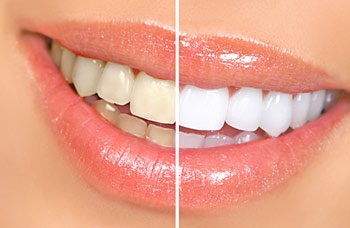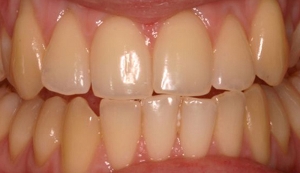Teeth whitening
 In modern culture, the prevailing perception is that white teeth make a smile charming and boost confidence. A white smile has become a business card of a happy and successful person. Moreover, for no reason, it is thought that white teeth are healthy teeth. Thus, in this case our perception and the perception of people around us is a decisive factor and it is really possible to change dental colour.
In modern culture, the prevailing perception is that white teeth make a smile charming and boost confidence. A white smile has become a business card of a happy and successful person. Moreover, for no reason, it is thought that white teeth are healthy teeth. Thus, in this case our perception and the perception of people around us is a decisive factor and it is really possible to change dental colour.
A radical change in colour is obtained when coating them with all-porcelain dentures or fillings of the desired colour (for more information see Aesthetical Adjustment of Dental Colour and Shape). This procedure is normally performed when teeth are affected by decay or other diseases. However, when teeth are healthy and bleaching them only in several shades is sufficient, a thorough cleaning of surface stains and additional bleaching with special pharmaceuticals are performed.
Why do teeth darken?
Teeth darken due to different causes which may be external and internal. External causes are food plaque, tobacco, heavy consumption of coffee, tea, red wine and other products high in teeth staining substances. Dental colour is also adversely affected by great fluctuations of temperature of food and drinks causing fractures in dental enamel due to which staining substances are easier absorbed.
Internal causes may be the following: inflammation of the dental pulp, dental traumas, treatment of root canals, filling of root canals with resorcin-formaldehyde paste used in the Soviet era which colours a tooth in pinkish brown colour, low-quality dental fillings, multiple decay, use of tetracycline during pregnancy causing teeth darkening in children, numerous reproduction of pigment producing bacteria in the mouth. Besides, teeth darken naturally with age because enamel is thinning and a darker internal layer of the tooth, i.e. dentine, is more clearly visible.
When can teeth be whitened?
When one is unhappy with the colour of teeth, they can be whitened. However, teeth whitening must be performed after professional oral hygiene during which soft and hard plaque (calculi) is removed. Moreover, an oral hygiene specialist removes stains accumulated on the rough dental surfaces by means of special sodium carbonate powder blower and restores the actual dental colour. Then, a patient may decide whether additional whitening by means of pharmaceuticals is required.
Prior to whitening, gingival inflammation and dental decay need to be cured. Teeth whitening should be postponed to later in case of pregnancy and lactation because in these conditions gums are more sensitive due to fluctuations in hormone levels.
It is important to remember that when performing teeth whitening fillings and dentures do not whiten, therefore, old restoration needs to be replaced. When planning for teeth whitening and restoration, whitening is performed first. After 14 days, when dental colour stabilises, filling or restoration may start.
What teeth whitening substances are used and how do they work?
Teeth whitening dates back to the end of the 19th century. Oxalic acid was used for this purpose. Since then, a lot of substances and methods have been tried (e.g. chloride, pyrozone, ammonia). Later, hydrogen peroxide was introduced in teeth whitening and has been used until now.
Treatment is completely safe under doctor’s supervision. Upon contact with the dental surface, hydrogen peroxide (H2O2) decomposes into water (H2O) and free oxygen (O). Free oxygen molecules penetrate into dental enamel and dentine, oxidise or terminate double bonds of protein stains there, therefore a tooth becomes white.
Scientific research has proven that such teeth whitening means used in accordance with instructions do not cause decay or erosions because their acidity (pH) is neutral. Probably, the worst that can happen when whitening teeth externally is the absence of results. A more dangerous treatment (because of a probability of spontaneous tooth melting (internal resorption) is whitening of endodontically treated teeth on the side of the pulp chamber. Therefore, this teeth whitening procedure is conducted only in the dental clinic.
What are teeth whitening methods? How are teeth whitened?
When all teeth are whitened, it is most convenient to whiten them at home. At first, standard or made-to-measure individual dental bleaching trays are selected at the dental clinic where bleaching gel is placed. At home, bleaching trays with bleaching gel are used on teeth for a certain period of time (usually one or four hours depending on the intensity of substances). Teeth usually whiten in 7–10 days.
When whitening from the inside is required (darkening after traumas, treatment of root canals) or when a rapid result is desired, whitening at the clinic may be opted for. Similar bleaching substances of greater concentrations are used. Depending on the dental colour and the desired result, the procedure may take 30–60 minutes. Taking into account the selected bleaching pharmaceutical, various sources of light may be used to catalyse its activity, i.e. laser, special lamps.
We consider whitening at home to be the most practical way to whiten teeth because in order to maintain the result achieved, the procedure may be repeated any time.
It is not recommended to consume teeth staining products (e.g. coffee, tea, red wine) during the first days after whitening.
How much do teeth whiten?

 Depending on age, the cause for the change in the dental colour, individual dental structure, thickness of enamel, concentration of bleaching substances and the method of whitening, teeth may be whitened in 2–5 shades.
Depending on age, the cause for the change in the dental colour, individual dental structure, thickness of enamel, concentration of bleaching substances and the method of whitening, teeth may be whitened in 2–5 shades.
What are side effects?
In some patients, dental sensitivity to cold and acids increases. After whitening, sensitivity usually disappears in several days. Additional medicine, special pastes, applications of fluorine gel, mouthwashes reducing dental sensitivity (consultation with the dentist is recommended) may be used. Scientific research has revealed that the amount of calcium and phosphorus in teeth reduces by 30 per cent due to very frequent teeth whitening, therefore, they become more fragile, enamel may start cracking.
It is highly important not to swallow bleaching substances in order not to irritate the oesophagus and stomach.
How long do teeth remain white?
Whitened teeth will always be lighter provided they are maintained properly (cleaned several times a day and professional oral hygiene performed twice a year) and no teeth staining products are consumed. Normally, follow-up treatment to maintain the whiteness is required once or twice per year. The situation is very similar to the efforts to maintain the selected hair colour.
specialists Contacts Doctor's appointment


